

 |
 |
The Perseid meteor shower is perhaps the most famous and reliable of all the annual meteor showers which the earth encounters each year during its cycle around the sun. The meteors originate from short period comet Swift - Tuttle and for several weeks during this period amateur astronomers around the world watch and photograph the sky in the hope of catching a nice display. This years peak activity takes place on Saturday 12/13th August however good meteor counts can be obtained several nights either side of maximum activity. I had been looking forward to the Perseids for weeks and my observing partner and I had planned on several all night watches as is our custom for all the major meteor showers of the year. The following is a summary of three nights of meteor action.
Friday/ 1 night before maximum / 22.40 - 03.45 BST.
This was an anxious period because if there is one thing that is predictable about the weather is it's unpredictability which certainly holds true for Northern Ireland. I had been checking the weather forecast all day on television and via the internet to estimate the chance of getting a clear sky tonight however things were not looking good as the latest update forecast cloudy skies and perhaps drizzle over Maghera which was pretty much the same as last night. However Conor and I would not give up so easily as we new from experience that the forecast is often inaccurate and besides all we needed was periodic clear breaks to see action. Even 100% clouds would not keep us in doors for a simple reason - over the last several nights there have been reports of tremendous fireballs in the mag - 20 to - 30 range which have been caught by meteor patrol cameras in Japan, fireballs in this range are the same magnitude as the sun and would easily penetrate through thick cloud and illuminate the countryside like daylight so if it meant spending a entire night under clouds to see one then so be it.
I bought some snacks to keep me fueled during the night and filled a flask with hot tea, charged the batteries in my camera and packed everything in my kit bag. As the sun set the clouds began to break and by 22.30 the sky was crystal clear so the weather forecast turned out wrong yet again. It was a calm, dry night, trans 8/10 and the moon was two days after full within Pisces which I could see rising in the NE complete with moon illusion and moon pillar. Many inexperienced observers curse the presence of a bright moon forcing them to give up and stay indoors. The reason being that many meteors are washed out by its strong light seriously reducing the count however this is simply not true. Fainter meteors will be washed out however showers like the Perseids and Geminids have numerous bright members that can cast shadows and in my own experience I can say that some of the best meteor activity I have witnessed took place under a bright moon.
I seen my first meteor of the night, a lovely mag 0 orange Alpha Ursa Majorid which shot through the NE sky. Conor arrived at my house then we walked one mile into the countryside outside Maghera to our favourite meteor observing location that involved circumventing several barbed wire fences and tracking across two fields in a stealthy manner until we arrived at a field with a good elevated position. With the exception of the NW we could see down to the horizon in all directions and of course there was no lights to bother us. Already we were seeing meteors and the activity seemed very good so Conor and I set up our digital cameras on tripods and began our photographic meteor patrol. I set my camera at ISO 800 / 15 second exposure at F/3.2.
We had been taking exposures for quite some time with no luck. Catching a meteor on camera is no easy feet - the sky is a big place so you need to have a bright meteor pass through your patrol area at the correct time. It's a little like fishing, it demands patience, persistence and a positive attitude only your fish are located in a celestial river and can swim in any direction at 60km/sec with no warning. Sometimes you get 'bites' were a meteor will pass the edge of the cameras field of view but not in it or else one does enter the field but is too faint for the camera to detect. The photographic meteor patrol is very exciting as you need to watch your patrol area very carefully knowing full well that one could appear at any moment, your adrenaline is pumping and so is your patience as you will often see meteors fall everywhere except the one place you want them to. The temptation to move the camera to a more productive area is strong however it is best to remain committed to your original target area.
We noticed that the vast majority of Perseids burned up in the low north within Ursa Major (Great Bear) so we concentrated our hunt there, it's a good job celestial bear hunting is not illegal! This was a good sector of sky that looked very promising, it was semi dark, a respectable distance from the radiant which was located east of the famous double cluster in Perseus and the moon was at our back. Several cups of tea and 200 patrol images later I got rewarded. A beautiful orange mag 1.0 Perseid with a long trail suddenly shot out from the radiant into Ursa Major..I let out a roar of triumph and previewed my capture on the LCD screen. I caught the meteor near the famous double star Alcor + Mizar and using digital zoom I could see that the meteor trail consisted of pink/red, silver and blue coloured segments which I had not seen before. I was delighted with my catch as this was my very first Perseid caught on camera! As it turned out Conor caught the very same meteor with his camera which was quite humorous at the time. We got our trophy of the night and the resulting roars must have woke the countryside from sleep!
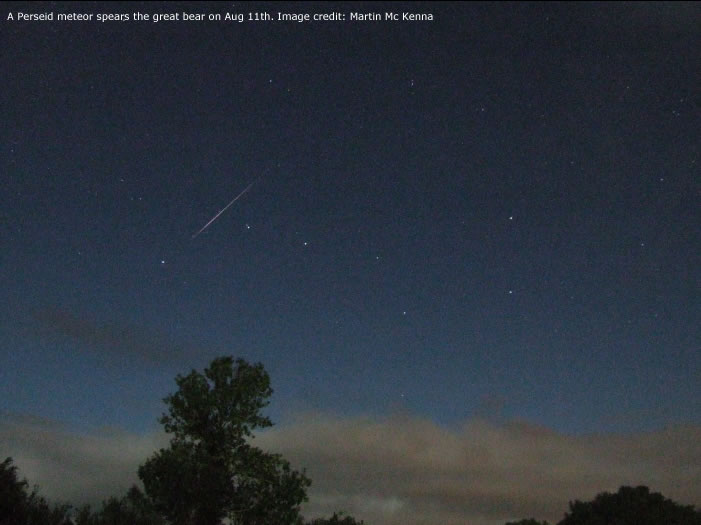 |
Time seemed to fly in tonight and before we new it we could see the glow of pre dawn low in the NE where Castor and Pollux rose to great us. The most exciting event of the night was a sudden burst of activity when I witnessed twin mag 0 Perseids falling again into Ursa Major like a fireworks display pointing down instead of up, this gave me a glimpse of what a fraction of a real meteor storm would look like!
 |
The night was a success, we counted 30 meteors of which 29 were Perseids - a count which exceeded our expectations. The clouds moved in after 03.00 and we felt a few drops of precipitation, it was obvious the clouds were moving in for good. We walked home again where I continued my watch until 03.45 then retired for the night. I heard the next day that I had missed a mag - 6 fireball by 60 seconds which appeared at 03.46 which was caught on a meteor patrol camera run by Robert Cobain! Conor and I both had a great night and if the activity was anything to go by then we suspected we could be in for a good show tomorrow night but only if we get clear skies?
Saturday / night of maximum activity / 18.30 - 04.40 BST
Tonight was the big night for action in the sky which I had been looking forward to for several months. Conor and I observe this shower every summer, I have been observing it ever since I began sky watching over ten years ago however cloudy skies have always been a problem from our location during August so I have missed many Perseids for this reason however the best shower I seen was in 2004 which Conor and I observed from outside Maghera which was partially clear. That night we bagged 115 meteors and 5 fireballs brighter than the full moon which lit the countryside like twilight for a second followed by loud sonic booms associated with the events. I have always wanted to beat the 115 mark and I reckoned it could be possible tonight if we could get the clear skies. May, June and July this year provided me with a record number of consistent clear nights throughout the summer however since August the weather has turned unsettled with constant clouds and drizzle so things were not looking promising but I kept a positive out look anyway. After studying the cloud charts we came to the conclusion that Maghera would most likely be cloudy but there was a long vertical clear strip in the cloud blanket that left the eastern side of Northern Ireland with clear skies with Larne in particular looking to be a productive place to watch meteors. The decision was made.
Things worked out for the best as the East Antrim Astronomical Society of which we are members of were holding their own Perseid watch and BBQ at their favorite observing location outside Larne at Killylane reservoir, a beautiful observing location. Fellow EAAS member Neill Patterson was kind enough to offer Conor and I a lift. He picked us up at 18.30 and by 19.30 we were set up in the car park over looking the wide expanse of blue choppy water that was Killylane lake. Several anglers were busy doing there thing and I seen several fish jumping high out of the water. Already breaks were forming in the clouds and thinks looked promising. We were treated to a beautiful crepuscular ray display with numerous bright golden rays with dark shadow bands.
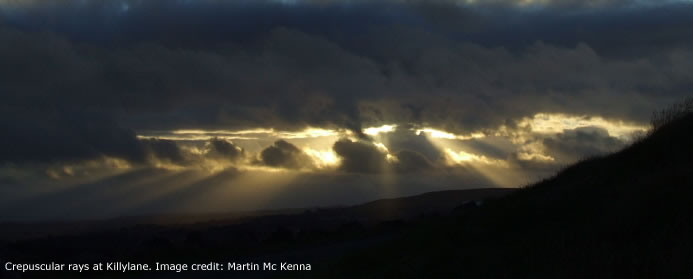 |
We ended up with approximately 15 observers waiting for darkness to fall. Before sunset Mark Stronge set set up his 80mm refractor and projected the suns image onto a sheet of card set on the car park ground. The suns disk was large and impressive with limb darkening and the new large sunspot group 903 which was split into two main groups with complex umbra, penumbra and light bridge. This group could very well erupt in the days ahead causing an aurora display.
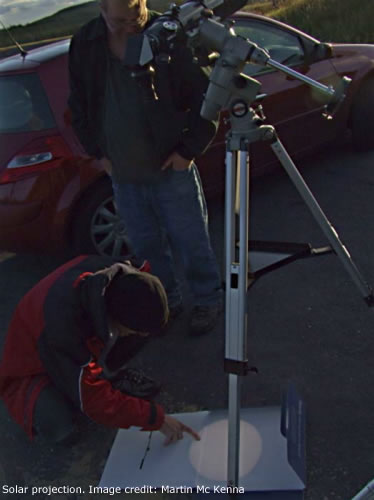 |
The BBQ was lit and we all had a good feed and chat. As the sun set planet Jupiter was the first object to appear out of the twilight and all scopes were turned in that direction. I had a nice view through Neill Mc Keowns ETX 70 mm were I could see all four of the gas giants large moons. As dusk fell the summer triangle appeared in the NE followed by the bright long period variable star Chi Cygni which is currently undergoing a significant outburst looking like a true Nova at the centre of the 'cross' asterism.
|
Meteors GaloreThe sky seemed to darken very quickly as the waning full moon (3 days after full) had not risen far above the NE horizon. We gathered in one corner sitting in chairs with others flat on the ground and immediately we began to see Perseids, Jonathan made the first visual catch of the night and very soon we had 6 within a very short period of time and they kept coming. I could glimpse stars at mag 6.0 and the milky way was faintly visible. When a meteor was seen the observer/s would shout and give a quick magnitude estimate, colour and physical description. I was sitting in a chair facing facing east and kept a count of every meteor. The sky was well covered and any meteors I missed were picked up by other observers. The majority of the meteors were a vivid orange colour and even the members on the mag 1.0 range left small elliptical short duration smoke trails in their wake. |
We seen 4 fireballs, 3 of which were mag - 4.0 and one at - 5.0 that left a long blue glowing ion train that pointed along the meridian.
|
Meteor observing is easy and fun. The Perseids are perhaps the best shower of the year as the maximum is in mid August, a time of year when the night sky is still relatively mild and many children are still on their summer holidays providing them with the rare chance to stay up late. If you want to carry out a serious Perseid count then one must be cautious as a wide selection of other minor showers are also active which can lead to confusion by beginners. These active showers are... Northern Delta Aquarids, Southern Delta Aquarids, Northern Iota Aquarids, Southern Iota Aquarids, Alpha Capricornids, Kappa Cygnids, Alpha Ursa Majorids. When a situation like this happens I always prepare in advance by checking the location of each shower radiant using online resources or 'starry night pro' desk top software. |
Begin a few nights before maximum and memorize the radiant positions within their parent constellations so when you do a see a meteor - back tracking its path through the sky will reveal its true origin, a process that becomes second nature with practice.
|
Everyone was having a great time as the Perseids put on a good show, the vast majority of members observed meteors while others sampled binary stars and deep sky objects with telescopes while beginners spent their time familiarizing themselves with the constellations using a planisphere. I started my own photographic patrol first in Cygnus then near Polaris at ISO 800 / 15 sec exp / at F/3.2 but had to periodically remove dew from the camera lens. The moon rose above the pine trees brightening the sky but this did not bother me much. I then took several hundred images without a catch, it was a very cool night and I caught myself shivering quite a bit but I paid it little attention as the Perseids were putting in an unexpected performance, the count was already approaching 90. Digital Meteor Hunting - First Catch Of The Night! |
EAAS chairman Mark Stronge came up with the good idea of arranging several SLR cameras at various strategic points to get maximum sky coverage which proved very effective. I was determined to get an image so I relocated to the other side of the car park facing north and set up my camera at this new location hoping for better luck. I collapsed the tripod legs to lower the height of the camera so I could get Steve's 4" TAL refracting telescope in the foreground with Ursa Major in the background, I had success with this sky area last night so I thought I would try my luck here again. I lay down on the cold ground and carefully watched the field taking one exposure after another in quick succession. A mag 2.0 orange Perseid with my name on it cut through the tail of the 'bear' passing not far from the twin galaxies M81 + M82 - my first capture of the night! I was very satisfied with the result even though the image was very noisy.
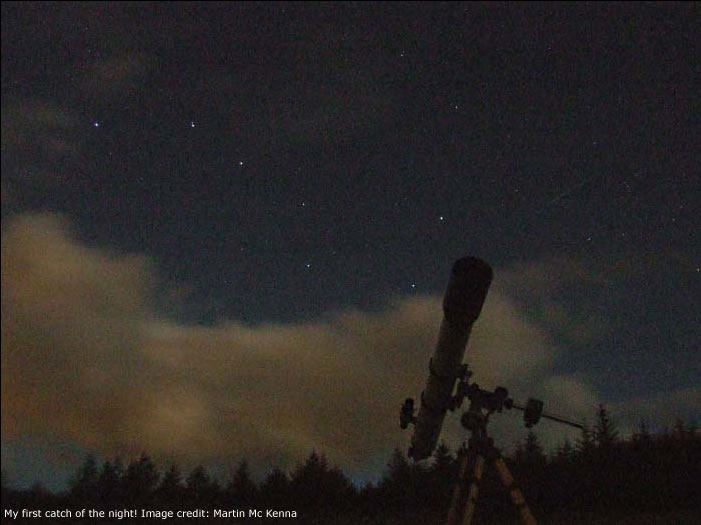 |
The group was very successful with many catching one or more Perseids using digital cameras. By now the count had reached 100 meteors! The international meteor organization predicted a possible enhancement of activity between 01.00 and 03.00 so I felt 100% confident that I would beat my best count of 115 - that is until thick clouds quickly created overcast conditions, I was disappointed that I would not make a new personal best and the clouds extending from horizon to horizon sent that thought home hard. The clouds stayed for several hours so we waited for a while and had a great chat with the remaining 'hardcore' observers until everyone decided to call it a night at 02.00 but I had a hunch that if we could make it back to Maghera in time the sky could be clear..there was some hope after all.
I was very tired during the long drive home and nearly fell asleep several times but I managed to force myself to keep awake to monitor the sky from the rear car window. It was 95% cloudy with M45 and the Hyades cluster visible in a gap. When we arrived at Maghera I was shocked to see a crystal clear sky - the show was not over yet by a long shot. Conor decided he would continue observing from his own home and I done the same thing from my own back garden. My sister informed me that it was clear over Maghera the entire night!
I set up my camera and tripod and continued my patrol. The moon was very high in the south with a light corona so I turned my back on it to concentrate my visual watch to a wide arc of sky covering the W - NE and the zenith. In a short time frame I seen 17 more meteors including a 'star burst' when 3 orange Perseids shot from the radiant at the same time. I had selected three patrol areas for the camera - Uma / Polaris in the N, Auriga / Taurus / M45 in the E and the 'summer triangle' high in the W above the rooftop of my house. I took another 100 images but the twilight glow was getting stronger by the minute so I focused my attention on Cygnus. The 'Fuji net' was cast over that area of sky then I got one!!! - another orange Perseid with long trail at mag 2.0 split the summer triangle peaking in magnitude near 'Jobs Coffin'. On the image I could see the trail along with Altair, Vega, Deneb and Chi Cygni with my house roof at the bottom of the frame. My 2nd Perseid capture of the night!
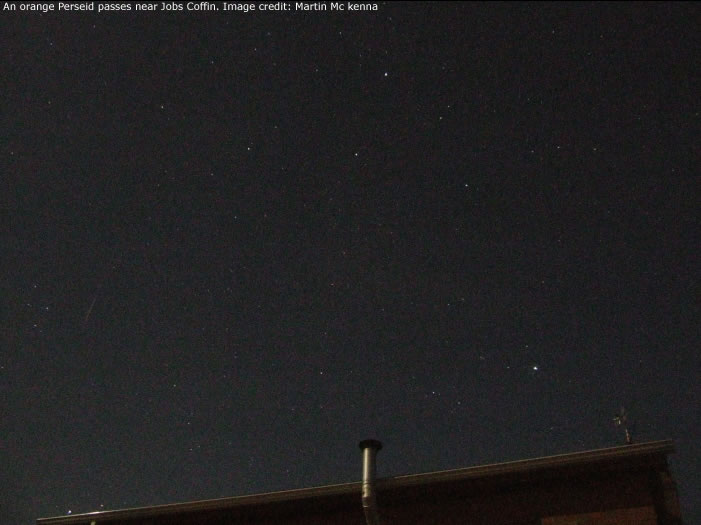 |
I ended my watch at 04.40 BST when the morning twilight began to wash out the stars significantly. I had seen a total of 137 meteors of which 132 were Perseids and the remaining 5 were non shower members. I had beat my previous record! considering the bright moon light and the 2 hours of clouds around peak activity I considered this a very good count. In fact this was the best Perseid display I have ever seen to date and would not be surprised when subsequent analysis might reveal heightened activity this year. The Perseids of 2006 far exceeded my expectations so not only did I set a new record but I also caught 2 with my camera in the same night and it all would not have happened without the unpredictable weather in N. Ireland which had reaffirmed my skepticism of any weather forecast.
Sunday / 1 night after maximum / 01.45 - 04.15 BST
I had planned a second watch tonight however clouds and drizzle ended that idea. Not wanting to give up I set my alarm clock to wake me during the pre dawn hours which it duly did. I wrapped up and walked out to my back garden. The sky was 95% cloudy with a few small gaps. At 02.36 BST I got a shock when a brilliant fireball appeared in the NE sky soaring through clouds at a steep angle towards the horizon. The head looked like a large sharp disk 1/2 degree in diameter, I could see the grey / white disk moving behind clouds in a general S to N direction. Due to the clouds it was difficult to ascertain any more information however I reckon it may have originated from the northern Iota Aquarid meteor shower and was Mag - 8.0 or greater. I heard no sound associated with the event. Unfortunately the meteor patrol cameras run by Robert Cobain and Armagh observatory did not pick this fireball up so I have not got any further confirmation.
The sky cleared completely and seemed alot darker as the moon was four days after full. I did another patrol with the camera and counted 15 meteors altogether of which 10 were Perseids and 5 were non shower meteors. Clouds ended session at 04.15 BST.
This week I have been observing Perseids over 5 nights of which 4 of them were clear / partially clear.
Total meteors observed = 191
Total Perseids observed = 178
Non shower Meteors = 13
Time spent Observing = 25 hours 45 minutes
Perseids captured on camera = 3
This year was a complete success and the good news is that next year the sky will be completely dark with no moon in the sky. What about the rest of this year? we still have the Orionids, Leonids, Taurids and Geminids to look forward to so keep checking nightskyhunter.com for reports. Happy meteor observing!
Martin McKenna